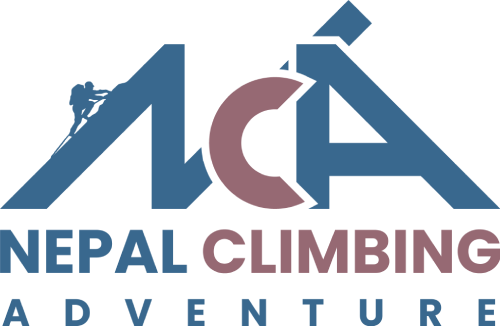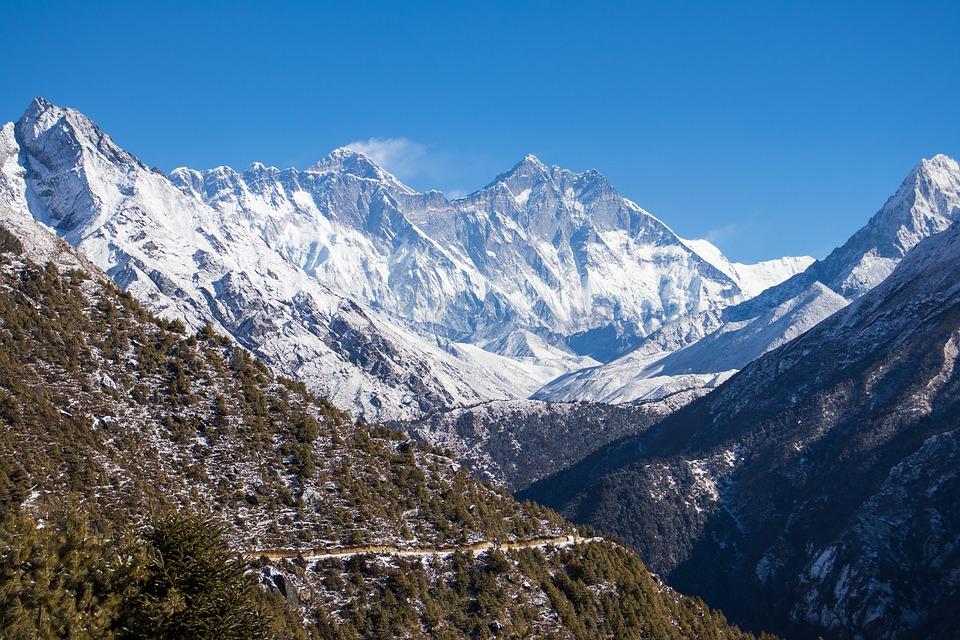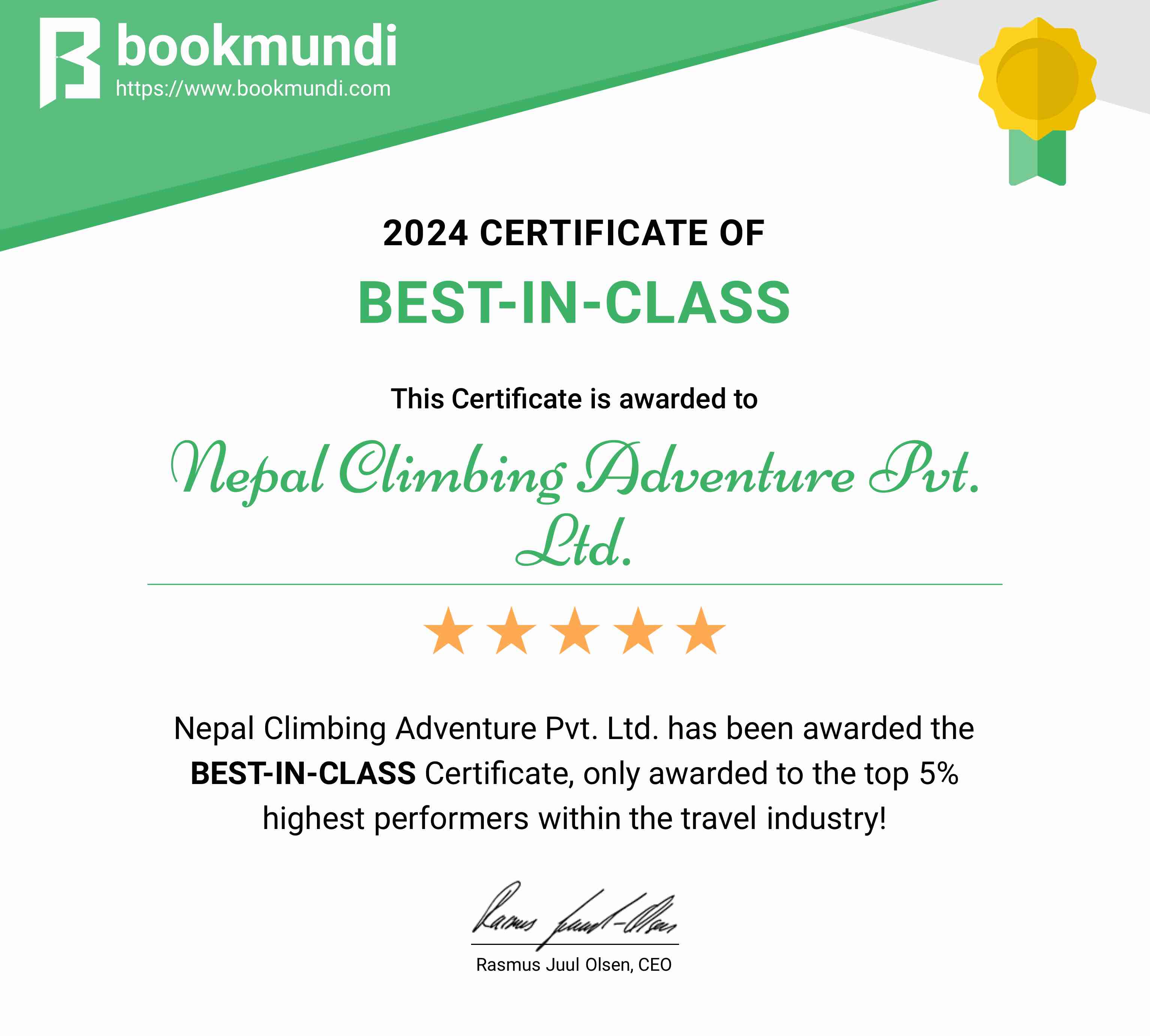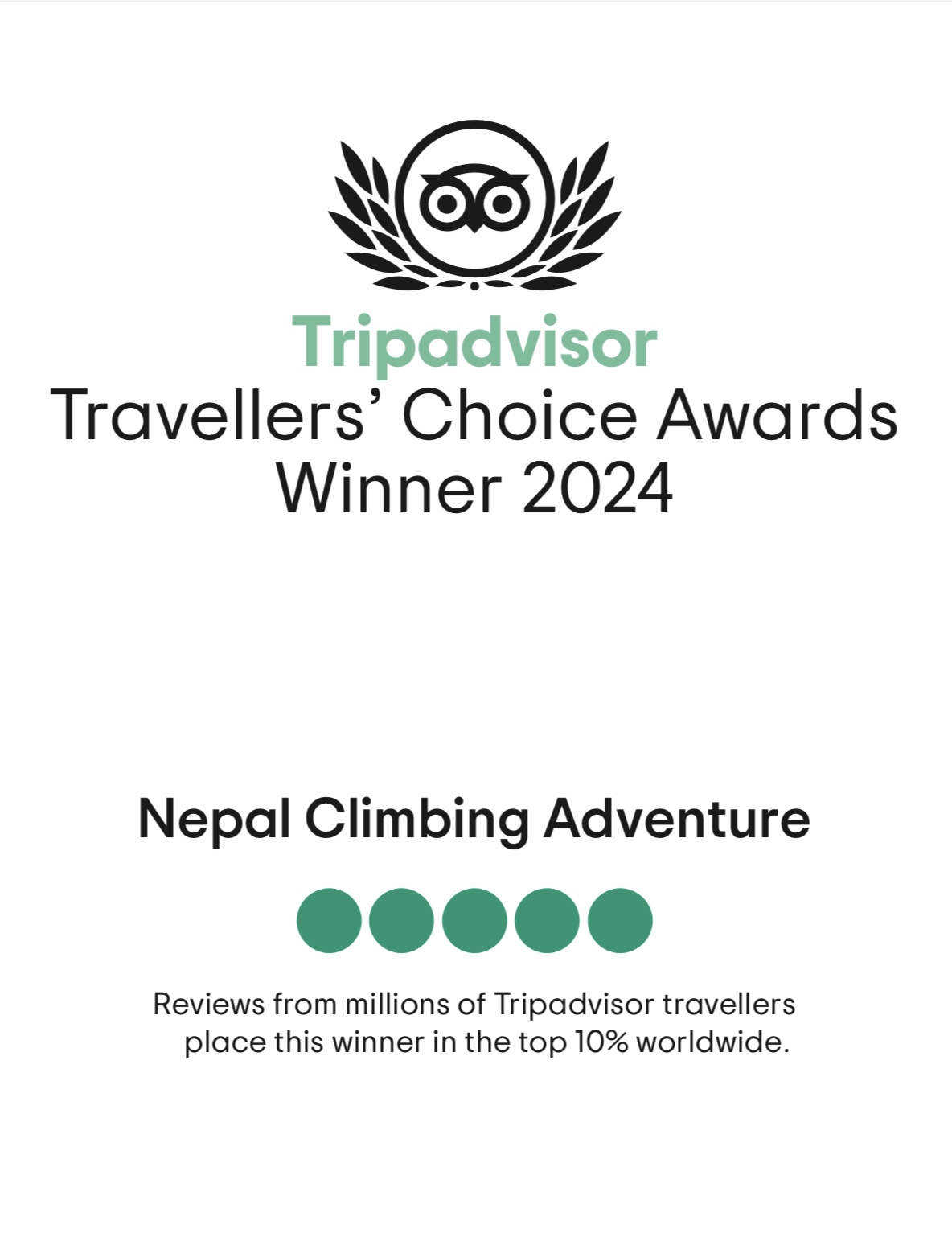Mt. Lhotse is the 4th highest peak in the world, which lies parallel to Mt. Everest. Lhotse Expedition is a wonderful climbing adventure for the seasoned climbers.
Mt. Lhotse is the 4th highest peak in the world, which lies parallel to everest, lhotse expedition is a wonderful climbing adventure for the seasoned climbers. With three distinct summits, Lhotse Shar, Lhotse East, and Lhotse Main, the mountain offers an unforgettable climbing experience of an 8000-meter mountain. Climbing this 8,516-meter high mountain in the close proximity of the highest mountain on earth is an adventure that many avid climbers want to go. This expedition is a perfect alternative option to Everest Expedition. The lhotse expedition tours come at a much lower cost than the Everest expedition but offer a similar kind of experience. It is a cheaper expedition than Everest because of its lower climbing permit fees. This expedition is also a perfect acclimatization climb for the climbers heading to the summit of the Mt. Everest.
Overview
This Expedition trip starts in Kathmandu on your arrival day and ends when you depart from Kathmandu. This adventure takes you on a trek to Everest base camp from where the actual climbing begins. When you trek towards the base camp, you will explore beautiful Sherpa villages, monasteries, nature, and peaceful surroundings.
Once you start the climb up from the base camp, you follow the same path as the Everest Expedition goes. The climbing path of the two mountains separates from a bit higher than the Yellow Band. You head towards the right towards Lhotse when the path diverges.
You climb the Khumbu IceFall above the base camp and follow the path. As the path progresses in the mountain, you reach the most challenging part of the expedition to Lhotse Couloir. It is a steep ice gully that rises as steep as 80 degrees up to 2.5 kilometers.
The climb has a demanding and challenging terrain with extreme climate. Heading towards the summit of Lhotse Main (8,516m), one has to be determined and an avid climber with previous climbing experience.
Although an incredible climbing adventure, this expedition is an easy climbing adventure for an 8,000-meter mountain. While you can go on this adventure as an independent trip, it can also be combined with the Everest Expedition.
Lhotse Expedition with Nepal Climbing Adventures:
The lhotse expedition tours will be guided by an expert team of experienced Sherpa climbers as your guides and porters at Nepal Climbing Adventure makes your expedition a safe adventure.
When you are on a climbing adventure with us, the safety of your life is the first priority in addition to taking the best decisions to make climbing a success. Our experienced Sherpa climbing guides will be with you all the time helping you set up camps, carrying things up in the mountains, planning the activities and schedules, and, most importantly, ensuring your safety and successful summit adventure.
Lhotse Mountain Expedition History:
Lhotse, the world's fourth highest peak, has a rich expedition history marked by numerous attempts and successful climbs since its first ascent in 1956. Situated in the Himalayas, Lhotse stands at 8,516 meters (27,940 feet) and is connected to Mount Everest through the South Col. The first successful summit of Lhotse was achieved on May 18, 1956, by a Swiss team led by Ernst Reiss and Fritz Luchsinger. Over the years, Lhotse has become a coveted challenge for mountaineers due to its steep faces and technical difficulty, particularly the Lhotse Face which is a prominent feature of its south side.
Many expeditions have faced harsh weather conditions, avalanches, and the physical challenges of high-altitude mountaineering while attempting Lhotse. Notable ascents include Reinhold Messner's solo ascent without supplemental oxygen in 1986 and the first winter ascent by a Polish team in 1988. The mountain continues to attract climbers from around the world, drawn by its formidable reputation and the allure of standing atop one of the highest peaks on Earth.
Best Time for Lhotse Peak 8516M Expedition:
The best time for this expedition is typically during the spring or autumn seasons. Spring, from April to May, and autumn, from late September to October, offer the most favorable weather and climbing conditions. During these periods, the weather is generally stable with clear skies, which provides better visibility and safer climbing conditions on Lhotse, the world's fourth highest peak.
In spring, the weather gradually warms up, allowing the snow and ice to stabilize, which is crucial for safe ascents. The days are longer, providing more daylight hours for climbing and acclimatization. Spring also coincides with the Everest climbing season, as Lhotse shares the same base camp and route up to a certain point, offering a communal atmosphere among climbers and support teams.
Autumn is another popular Lhotse expedition season due to similar weather conditions. The temperatures begin to cool after the summer monsoon season, reducing the risk of avalanches and other weather-related hazards. The skies are generally clear during autumn, offering stunning views of the Himalayan landscape and making it an ideal time for photography and enjoying the natural beauty of the region.
Both seasons attract climbers from around the world seeking to conquer Lhotse's challenging slopes. Experienced mountaineers often prefer these periods for their expeditions due to the predictable weather patterns and optimal climbing conditions. However, climbers must always be prepared for sudden changes in weather in the high-altitude environment of the Himalayas and adhere to safety protocols to ensure a successful and safe ascent of Lhotse.
Lhotse Climbing Tips:
When attempting to climb Lhotse, which is the fourth highest peak in the world, it is important to be aware of the unique challenges it presents and to thoroughly prepare. Here are some essential tips to keep in mind:
- Physical Conditioning: Prioritize rigorous physical training, focusing on cardiovascular endurance, strength training, and altitude acclimatization. Build stamina for extended climbs and harsh conditions.
- Acclimatization Strategy: Plan a gradual ascent to allow your body to adjust to higher altitudes. This helps prevent altitude sickness and enhances your overall performance during the climb.
- Technical Skills: Master technical climbing skills, including ice and rock climbing techniques. Familiarize yourself with using crampons, ice axes, ropes, and harnesses in challenging terrain typical of Lhotse.
- Weather Awareness: Stay informed about weather patterns and forecasts. Be prepared for sudden changes in weather conditions, which can significantly impact your climb and safety.
- Equipment: Ensure you have high-quality gear suitable for extreme cold and high altitudes. This includes down suits, insulated boots, goggles, and a reliable tent and sleeping bag designed for low temperatures.
- Team and Support: Join a reputable expedition team with experienced guides who understand the mountain's intricacies. Collaborate closely with your team members, fostering trust and effective communication.
- Safety Protocols: Adhere to strict safety protocols, including using fixed ropes where necessary, maintaining proper hydration and nutrition, and observing rest periods to avoid exhaustion.
- Respect the Environment: Practice Leave No Trace principles to minimize your impact on the mountain environment. Respect local customs and regulations governing climbing in the region.
- Mental Preparedness: Develop mental resilience to cope with physical exertion, altitude challenges, and potential setbacks. Stay focused and adaptable during the ascent.
- Emergency Plans: Familiarize yourself with emergency procedures and evacuation routes. Carry necessary medical supplies and communicate your itinerary with support teams for coordinated responses to emergencies.
Lhotse Summit Success Rate:
The summit success rate of Lhotse, the fourth highest mountain globally at 8,516 meters (27,940 feet), varies yearly. Typically, around 26% to 39% of climbers attempting Lhotse reach its summit. Factors influencing this include weather conditions, technical challenges of the route, and individual climber experience. Lhotse shares its base camp with Mount Everest, making it a popular choice for climbers aiming to summit both peaks during the same expedition. Despite its proximity to Everest, Lhotse presents unique challenges, including the notorious Lhotse Face and the steep final ascent to the summit, impacting overall success rates.
Lhotse Climbing Permits:
Climbing Lhotse, the world's fourth highest mountain at 8,516 meters (27,940 feet), requires obtaining permits due to its location on the Nepal-China border. To climb from the Nepalese side, climbers must secure permits from the Nepalese government's Department of Tourism. These permits detail expedition dates, routes, and the number of climbers, contributing to conservation and local development efforts through associated fees. Additionally, trekking permits for Sagarmatha National Park are often required as the route to lhotse base camp trek passes through this UNESCO World Heritage site, protecting its unique biodiversity.
On the Tibetan side, permits are obtained through the Chinese Mountaineering Association and Tibetan authorities, following similar guidelines for route planning and environmental protection. Both processes emphasize minimizing environmental impact, respecting local cultures, and ensuring Lhotse climbing expedition safety with the support of experienced sherpa guides. These permits and regulations are crucial for maintaining the integrity of the mountain environment while allowing climbers to undertake the challenging ascent of Lhotse.
Lhotse Weather Conditions:
Lhotse, towering at 8,516 meters (27,940 feet), faces harsh Himalayan weather year-round. In spring (March to May), temperatures at Lhotse base camp average around -20°C (-4°F), with climbers encountering occasional snowstorms and high winds, especially higher up. Autumn (September to November) brings colder temperatures, about -15°C (5°F) at base camp, but clearer skies favoring summit attempts. Winter (December to February) sees extreme cold, often below -30°C (-22°F), along with intense winds and dangerous wind chills. Summer (June to August) brings monsoon rains, making climbing hazardous due to slippery, unstable conditions and poor visibility. Climbers must carefully plan and adapt to these variable conditions, monitoring forecasts closely and acclimatizing properly to mitigate risks. Despite the challenges, the allure of conquering Lhotse's summit draws adventurers seeking to navigate its formidable weather and breathtaking heights.
Lhotse Climb Difficulty:
Climbing Lhotse presents a formidable challenge even among the world's highest peaks. As the fourth highest mountain globally, Lhotse stands at 8,516 meters (27,940 feet) and is located in the Everest region of the Himalayas. Its difficulty lies in its steep and icy terrain, coupled with unpredictable weather conditions that can change rapidly. The climb requires technical expertise in ice and rock climbing, as well as high-altitude mountaineering skills due to the extreme altitude.
One of the main challenges climbers face on Lhotse is the notorious Khumbu Icefall, a treacherous area of shifting ice towers and crevasses near Everest's base. Climbers must navigate this hazardous section carefully to reach higher camps on the mountain. The ascent from Camp 3 to the summit involves climbing the steep Lhotse Face, a demanding and exposed route that tests climbers both physically and mentally.
Due to its proximity to Mount Everest, Lhotse shares similar weather patterns, including high winds and low temperatures, which can make summit attempts risky and unpredictable. Proper acclimatization and careful planning are essential for climbers attempting Lhotse, as well as a Lhotse summit climbing expedition team strongly supports and experienced guides to navigate the challenges of the climb safely.
Lhotse Climbing Route:
Lhotse, the world's fourth highest peak, offers climbers a challenging ascent via its South Col route. Situated in the Everest region of the Himalayas, Lhotse stands at 8,516 meters (27,940 feet). The climbing route typically begins from Everest Base Camp, following a path that initially parallels the Everest route up to Camp 2. From there, climbers ascend the Lhotse Face, a steep icy slope that demands technical skill and endurance. Camp 3 is established above this face, providing a crucial resting point before the final push to the summit.
The route then progresses through the narrow and exposed Geneva Spur before reaching the South Col at approximately 7,900 meters (25,900 feet). From the South Col, climbers face the final challenge: a steep and icy couloir leading directly to the summit ridge. The summit push often involves navigating around crevasses and seracs, making it a physically and mentally demanding climb. Despite its proximity to Everest, Lhotse maintains its own distinct challenges and rewards for mountaineers seeking to conquer one of the world's highest peaks.
Lhotse South Face:
The Lhotse South Face is one of the most challenging and awe-inspiring features in the Himalayas. It's renowned for its sheer vertical drop and immense size, standing as the steepest face of any 8,000-meter peak. Located near Mount Everest in the Khumbu region of Nepal, this formidable wall rises sharply from the Lhotse Glacier below. Climbers consider it one of the ultimate tests of mountaineering skill and endurance due to its technical difficulties, severe weather conditions, and the significant risk of avalanches and rockfalls.
The route to the summit requires expert ice and rock climbing abilities, as well as a high level of physical fitness and mental fortitude. Despite numerous attempts, the South Face was first successfully climbed in 1984 by a Russian expedition. Since then, only a handful of climbers have managed to reach the top via this challenging route. The Lhotse South Face stands as a testament to the extreme challenges and dangers inherent in high-altitude mountaineering, attracting only the most skilled and determined climbers from around the world.
Lhotse Expedition Logistics:
Planning this expedition involves meticulous logistics to navigate one of the world's tallest peaks. Located in the Himalayas, Lhotse stands adjacent to Mount Everest, requiring climbers to adhere to strict schedules and preparations. The expedition typically begins in Kathmandu, Nepal's capital, where climbers assemble and finalize Lhotse summit climbing expedition gear checks. From there, a flight to Lukla kicks off the trekking phase, leading through rugged terrain and picturesque Sherpa villages. Base camp establishment involves setting up tents and acclimatization routines crucial for adjusting to high altitudes. Climbers undergo multiple rotations between camps to acclimatize further and familiarize themselves with the route.
Sherpa guides play a pivotal role in assisting with navigation and providing support throughout the Lhotse ascent. Logistics include managing oxygen supplies, food provisions, and emergency contingencies. Weather windows dictate summit attempts, requiring careful monitoring and readiness. Successful expeditions celebrate reaching the summit, followed by a challenging descent back to base camp and eventually, Kathmandu. Each aspect of the expedition demands careful planning and execution to ensure safety and success amidst one of the world's most formidable mountain environments.
Detailed Lhotse Expedition Itinerary:
Let's dive into the Lhotse Peak 8516M Expedition itinerary, a thrilling adventure through the Himalayas blending challenging climbs with breathtaking views.
Day 01: Arrival in Kathmandu
Upon arrival in Kathmandu, you'll be greeted and transferred to your hotel. Take the rest of the day to relax and adjust to the new time zone. Depending on your arrival time, you might explore the nearby streets or enjoy a leisurely evening at the hotel, preparing for the adventure ahead.
- Accommodation: Hotel
- Meal: N/A
Day 02: Kathmandu
After having breakfast, start a guided tour of the cultural highlights of Kathmandu. Begin by visiting Swayambhunath Stupa, which is also known as the Monkey Temple and offers panoramic views of the Kathmandu Valley. Then, explore the sacred Pashupatinath Temple, dedicated to Lord Shiva, and observe the Hindu cremation rituals taking place on the banks of the Bagmati River. Finally, visit Boudhanath Stupa, one of the largest stupas in Nepal, which is surrounded by Tibetan Buddhist monasteries. Return to your hotel in Kathmandu for an overnight stay.
- Accommodation: Hotel
- Meal: Breakfast
Day 03: Kathmandu
Today is free for you to explore more of Kathmandu at your own pace. You may choose to visit Patan Durbar Square, known for its fine arts and historical architecture, or Bhaktapur Durbar Square, famous for its ancient temples and traditional Newari culture. Alternatively, you can spend the day shopping for trekking gear and souvenirs in Thamel, Kathmandu's bustling tourist district.
- Accommodation: Hotel
- Meal: Breakfast
Day 04: Phakding
Fly to Lukla, where your trek to Everest Base Camp begins. From Lukla, trek to Phakding along a trail that descends through picturesque Sherpa villages and past prayer wheels and Mani stones. Cross several suspension bridges over the Dudh Koshi River, enjoying the first views of Everest in the distance. Arrive in Phakding and settle into your lodge for the night, where you'll enjoy your first taste of traditional Nepali hospitality.
- Accommodation: Lodge
- Meal: Breakfast, Lunch, Dinner
Day 05: Namche Bazar
The trek today will lead you from Phakding to Namche Bazar, which serves as the entrance to Everest. The path meanders through pine forests and crosses the Dudh Koshi River several times using suspension bridges decorated with prayer flags. You will climb steeply to reach Namche Bazar, where you will be greeted with your initial glimpses of Everest and the surrounding peaks. Namche Bazar is a lively Sherpa town filled with shops, cafes, and breathtaking mountain views. Enjoy your stay in a lodge and immerse yourself in the vibrant ambiance of this mountainous town.
- Accommodation: Lodge
- Meal: Breakfast, Lunch, Dinner
Day 06: Khumjung
Trek from Namche Bazar to Khumjung, a tranquil Sherpa village nestled in the foothills of Khumbila, the sacred peak of the Khumbu region. The trail offers spectacular views of Everest, Lhotse, and Ama Dablam as you pass through yak pastures and small settlements. Explore Khumjung's monasteries and visit the Hillary School, established by Sir Edmund Hillary. Overnight in a lodge in Khumjung, enjoying the serene mountain surroundings.
- Accommodation: Lodge
- Meal: Breakfast, Lunch, Dinner
Day 07: Tengboche
Continue your trek to Tengboche, known for its famous monastery, the largest in the Khumbu region. The trail climbs through rhododendron forests and opens up to panoramic views of Everest, Nuptse, and Ama Dablam. Visit Tengboche Monastery, a spiritual center for Sherpas, and attend a prayer ceremony if possible. Overnight at a lodge in Tengboche, soaking in the peaceful ambiance of this sacred mountain site.
- Accommodation: Lodge
- Meal: Breakfast, Lunch, Dinner
Day 08: Dingboche
Trek from Tengboche to Dingboche, crossing the Imja River and trekking through beautiful pastures with grazing yaks. Enjoy views of Island Peak and other stunning peaks along the way. Dingboche is a summer settlement with terraced fields, where you'll spend the night in a lodge, acclimatizing to the increasing altitude.
- Accommodation: Lodge
- Meal: Breakfast, Lunch, Dinner
Day 09: Dingboche
Today is a rest day to aid acclimatization before ascending further. You can take a day hike to Nagarjun Hill for breathtaking views of Makalu, Lhotse, Cho Oyu, and Everest, or explore Dingboche village and its surroundings. Relax and prepare for the challenges ahead while enjoying the tranquility of Dingboche.
- Accommodation: Lodge
- Meal: Breakfast, Lunch, Dinner
Day 10: Lobuche
Trek from Dingboche to Lobuche, passing through Dusa and Thukla with memorials dedicated to climbers who lost their lives on Everest expeditions. The trail ascends gradually, offering panoramic views of the Himalayan peaks. Arrive in Lobuche, a small settlement nestled in a rocky moraine, and settle into your lodge for the night. Prepare for the final leg of your trek to Everest Base Camp.
- Accommodation: Lodge
- Meal: Breakfast, Lunch, Dinner
Day 11: Everest Base Camp
Today is the culmination of your trek as you journey from Lobuche to Everest Base Camp. The trail traverses the Khumbu Glacier, with spectacular views of Pumori, Nuptse, and other towering peaks. Celebrate reaching Everest Base Camp, a surreal and exhilarating experience surrounded by some of the world's highest mountains. Overnight camping at Base Camp, soaking in the accomplishment and the natural beauty that surrounds you.
- Accommodation: Camping
- Meal: Breakfast, Lunch, Dinner
Day 12 - Day 49: Climbing Period
The next phase involves training and acclimatization for the climb. Under the guidance of experienced climbers and guides, you'll prepare for summit attempts based on weather conditions and team readiness. The days will be structured with practice climbs, rest periods, and strategic planning to maximize safety and success.
- Accommodation: Camping
- Meal: Breakfast, Lunch, Dinner
Day 50: Cleaning the Base Camp
Participate in the environmental effort to clean and restore the Base Camp area, ensuring it remains pristine for future expeditions. This is a meaningful activity to contribute to responsible trekking practices in the Himalayas. Overnight camping at Base Camp, reflecting on the journey and camaraderie built during your time here.
- Accommodation: Camping
- Meal: Breakfast, Lunch, Dinner
Day 51: Pheriche
Descend from Everest Base Camp to Pheriche, retracing your steps through the Khumbu Glacier and picturesque landscapes. Arrive in Pheriche, a small village known for its scenic beauty and hospitality. Overnight at a lodge in Pheriche, enjoying the warmer temperatures and lower altitude.
- Accommodation: Lodge
- Meal: Breakfast, Lunch, Dinner
Day 52: Namche
Continue descending from Pheriche to Namche Bazar, passing through Tengboche and enjoying downhill trails with panoramic mountain views. Arrive in Namche Bazar, where you can relax and reflect on your journey over a hot meal and comfortable lodge accommodation.
- Accommodation: Lodge
- Meal: Breakfast, Lunch, Dinner
Day 53: Lukla
Trek from Namche Bazar to Lukla, your final day of trekking in the Everest region. The trail descends through pine and rhododendron forests, with occasional glimpses of wildlife. Celebrate your achievements with your trekking team upon reaching Lukla. Overnight at a lodge in Lukla, reminiscing about the incredible landscapes and experiences of the past weeks.
- Accommodation: Lodge
- Meal: Breakfast, Lunch, Dinner
Day 54: Kathmandu
Fly back to Kathmandu from Lukla, where you'll transfer to your hotel upon arrival. Enjoy a well-deserved rest in the comforts of Kathmandu, perhaps exploring more of the city's cultural sites or indulging in a celebratory meal. Overnight stay at your hotel in Kathmandu.
- Accommodation: Hotel
- Meal: Breakfast
Day 55: Kathmandu
Today is a free day in Kathmandu for leisure activities or optional sightseeing. You may choose to visit additional cultural sites, such as Bhaktapur Durbar Square or the Garden of Dreams, or simply relax and shop for souvenirs in Thamel. Enjoy your last day in Nepal, reflecting on the incredible journey to Everest Base Camp and the friendships forged along the way.
- Accommodation: Hotel
- Meal: Breakfast
Day 56: Departure
Transfer to the airport for your departure flight, marking the end of your unforgettable trekking adventure and climbing expedition. Depart Nepal with memories of breathtaking landscapes, cultural richness, and the personal triumph of reaching the world's highest mountain region.
- Accommodation: N/A
- Meal: Breakfast
What is included?
- Pick up and drop off on your arrival and departure
- Hotel accommodation in Kathmandu
- Lodge and Camping accommodation during trekking and climbing
- Breakfasts in Kathmandu; all meals in the mountains
- Kathmandu-Lukla-Kathmandu flight ticket
- Kathmandu Sightseeing Tour
- Experienced Sherpa climbing guides and porters
- All necessary permit for the adventure
- Climbing equipment and all necessary logistics
What is not included?
- International flight ticket and insurance
- Lunch and dinner in Kathmandu
- Expenses of personal nature
- Tips to guides and porters
- Any emergency cost incurred on uncontrollable situation
- Any other things not mentioned in the 'Includes' section
There are a number of things that you need to keep in mind if you ever plan for your vacation. Because you want to make the most out of your limited time, it is truly a hectic job for you to find a trustworthy and experienced traveling companion. With Nepal Climbing, you have your problem solved already as we are one of the leading Trekking and Mountaineering organizations in Nepal and have been providing first class service in several travelling packages across the country for many years.
We prioritize your satisfaction and safety
At Nepal Climbing Adventure, our ultimate objective is to arrange the programs for you to make the most out of your valuable time. We value your satisfaction, adventure, amusement and safety. Regardless of whether you are searching for stunning perspectives along the trekking trails in Himalayan mountain range or widely acclaimed, heavenly attractions with developed societies, our exposure and experience in travel business will help you ensure your requirements are met.
We have professional staffs and service
We trust that extraordinary staff lead awesome administration. That is the reason we are collaborated with experienced and eager individuals. We possess authorized and government certified guides who are very much furnished with broad learning of Nepali communities and traditions. They additionally have familiar English speaking abilities and hierarchical capacities to encourage all types trekking groups.
Responsible Tourism and social values
We are endeavoring to lessen the effect of tourism by guaranteeing our staff are very much aware of ecological issues. We are doing our best to create less waste as could be expected under the circumstances and make a point to reclaim non-compostable wastes. We outline our itineraries and work in the field guided by the standards of ecotourism and reasonable tourism. Moreover, all our staff have been given ecological preparing and are extremely aware to the eco-system we enter. Additionally, we are adhering to sustainable assets of energy. Our guides will share you the social values, culture and religious harmony for better understanding the groups you visit.
Customizable Service
Our promise is to provide you with the travelling packages customizable according to your demand fulfilling your budget criteria. So, we can facilitate a minimum of 2 individuals with a personalized service at a reasonable cost.
Online Payment
Or
WIRE TRANSFER
Bank Details:
Account Holder's Name: Nepal Climbing Adventure Pvt. Ltd.
Bank Name: Himalayan Bank Ltd.
Account Number: 01907449340018
Account Type: USD
Address: Thamel, Kathmandu, Nepal
SWIFT CODE: HIMANPKA
For more detail contact us:
Krishna Subedi (Chris Chhetri): +977 9851076791 (24/7, Call/Viber/Watsapp)
We recommend our guests have a valid insurance policy before undertaking an adventure in Nepal Himalaya. During treks and expeditions, the insurance should cover for expenses such as air ambulance, helicopter rescue, and medical care. As an adventure operator, we (NCA), are not permitted to arrange or sell insurance packages here in Nepal as per the Government of Nepal.
Frequently Asked Questions (FAQs):
1. Lhotse is in which country?
Lhotse is located on the border between Nepal and the Tibet Autonomous Region of China. It is connected to Mount Everest via the South Col.
2. How tall is the peak of Lhotse?
The peak of Lhotse stands at an impressive elevation of 8,516 meters (27,940 feet) above sea level, making it the fourth highest mountain in the world. Its prominence in the Himalayas attracts climbers from around the globe seeking to conquer its challenging slopes and reach its summit.
3. What is an interesting fact about Lhotse?
An interesting fact about Lhotse is that its name means "South Peak" in Tibetan, reflecting its position south of Mount Everest. The Lhotse Face, a steep icy wall on its south side, is one of the most technically demanding sections of the climb, adding to its reputation as a formidable peak in the Himalayas.
4. Why climb Lhotse?
Climbing Lhotse presents a formidable challenge and is often pursued by experienced mountaineers seeking to test their skills at high altitude. Its proximity to Everest adds to its allure, offering climbers a chance to summit the world's fourth highest peak and experience breathtaking views of the Himalayas from a unique vantage point.
5. Is Lhotse more difficult than Everest?
Lhotse is often considered more technically challenging than Everest, primarily due to its steep faces and narrow ridges. Climbing Lhotse involves similar altitude and weather challenges as Everest, but its specific features, like the notorious Lhotse Face, make it a demanding ascent even for experienced climbers.
6. How difficult is Lhotse to climb?
Climbing Lhotse is highly challenging due to its steep terrain, particularly the Lhotse Face and the final push to the summit. Lhotse climbing experience requires advanced mountaineering skills, with high-altitude conditions, and careful planning to navigate the technical aspects of the climb successfully.
7. Why is Lhotse not part of Everest?
Lhotse and Everest are distinct peaks despite their close proximity and shared base camp area. They are separated by the South Col, a saddle-shaped pass, and have different summit points. Despite being connected in the Himalayan range, each peak maintains its own distinct identity and climbing challenges.
8. How long does a typical Lhotse expedition take?
This expedition usually takes around 6-8 weeks, depending on weather conditions, acclimatization needs, and the overall climbing team's pace.
9. Is it possible to climb Lhotse independently?
Climbing Lhotse independently is rare due to the technical challenges and logistical support needed. Most climbers join organized expeditions with experienced guides and support staff.
10. What equipment is needed for this expedition?
Essential gear includes high-altitude mountaineering clothing, climbing boots, ropes, ice axes, crampons, helmets, tents, sleeping bags, and oxygen tanks for high camps.





















 Chris Chhetri
Chris Chhetri